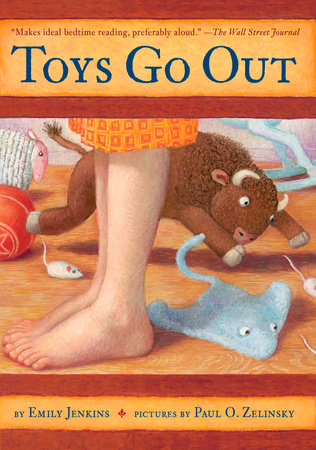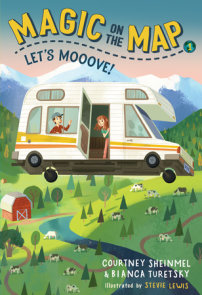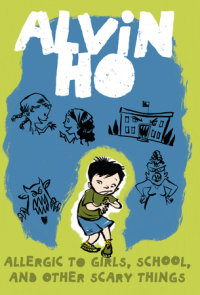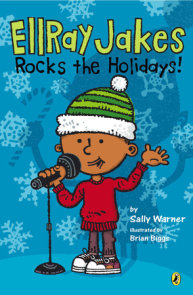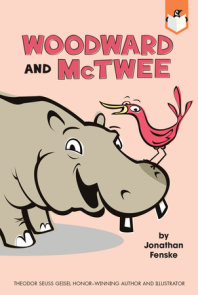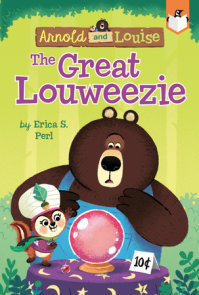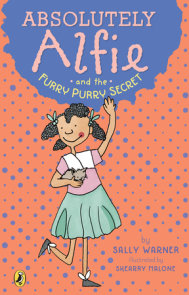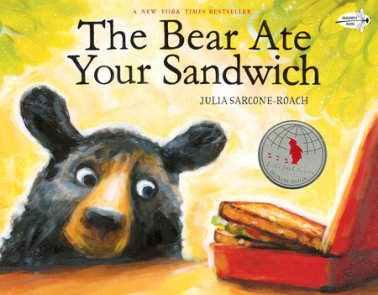TEACHING GUIDE
ABOUT THIS BOOK
Meet Lumphy, Stingray, and Plastic!
Toys coming alive? It is every child’s dream, but a reality for the Little Girl whose toys sing, dance, and play while no one is looking. Their antics around the house often get them into trouble, but they are quick to come to the rescue of their friends. They test their bravery, learn about forgiveness, and show unwavering love for the Little Girl. Follow along as these small toys create big adventures.
Grades 1—5
ABOUT THIS AUTHOR
Emily Jenkins is the author of numerous highly acclaimed books for children. She lives in Brooklyn, New York.
Paul O. Zelinsky’s retelling of the classic fairy tale Rapunzel received the 1998 Caldecott Medal. He lives in Brooklyn, New York.
TEACHING IDEAS
Chapter 1
In the Backpack, Where It Is Very Dark
It is dark in the Little Girl’s backpack. Very dark. Lumphy, StingRay, and Plastic are scared. Where are they going? Their imaginations are wandering, and they are terrified of the possibilities. The veterinarian, the zoo, the garbage dump? The toys are pleasantly surprised to learn that the Little Girl has brought them to school for Show and Tell. She must really love them! The backpack ride home just doesn’t seem as scary anymore.
For Discussion
Talk about a time when you were scared. Where were you? What was going on around you? How did the situation end?
Class Activity
Making Predictions—Create new endings to the backpack adventure. Lumphy, StingRay, and Plastic are cramped in the dark backpack. Where are they going? The backpack thumps down with a bang, the zipper opens slowly and . . . Have students finish the story in their writing journal, and then ask them to read their adventures aloud to the class.
Chapter 2
The Serious Problem of Plastic-ness
Plastic takes books very seriously, and spends some time reading one of the Little Girl’s schoolbooks about animals. She reads all about stingrays, buffaloes, sheep, and mice, but she can’t seem to find any pictures that look like her. Feeling very confused about her identity, she searches the dictionary for help. This only tells her what plastic is used for. TukTuk, the yellow bath towel, comes to her rescue by revealing exactly what she is. A round, red, bouncy rubber ball!
For Discussion
Describe yourself using physical characteristics. Do you resemble others in your family?
Class Activity
Art—Pass out handheld mirrors to each student. Ask them to look closely at themselves in the mirror. Guide them through looking at the shape of their eyes, the curve of their chin, the color of their hair, etc. Then have them draw exactly what they see. When they are finished with their portraits, post all of them on the board and ask the students to identify which drawing belongs to whom.
Chapter 3
The Terrifying Bigness of the Washing Machine
Lumphy finds himself covered in greasy peanut butter. This means only one thing—that he will be sent to the washing machine in the dark, dirty basement. To avoid this fate, Lumphy hides in the Little Girl’s closet. The Little Girl searches for him for days with no luck. Lumphy hates to see her cry, and makes the decision to come out of hiding and face his fears. Luckily, Frank the washing machine is very friendly and helps Lumphy through his spin cycle with a little song and dance.
For Discussion
Talk about a time when you had to face your fears. What were you afraid of and how did you conquer that fear? Did anyone help you make it through? Explain that this is a very brave thing to do, and that students should feel proud of their accomplishment.
Class Activity
Self-Respect—Have students make medals in honor of the time when they faced their fears. Their names should be on one side, and a description of what they did should be on the other side. Hang the medals from ribbons so that students can wear them with pride!
Chapter 4
The Possible Shark
Plastic is on her way to the beach with the Little Girl, and StingRay is left at home feeling very jealous. Just because Plastic can float in the ocean doesn’t mean that she is more fun to play with. Yet, they both find themselves in deep trouble. Plastic is tossed into the ocean and attacked by a “shark,” while StingRay is determined to float but is close to drowning in the bathtub. After similar ordeals, StingRay and Plastic reconcile their differences and remain good friends.
For Discussion
Why does Plastic float but StingRay sinks? What is different about their physical properties?
Class Activity
Science—Conduct an experiment that compares things that float with things that sink. Gather items that will either float or sink and present them to the class. Ask them to make predictions of what will happen when each item is placed in water. Then test each item and have students compare the results to their predictions.
Chapter 5
How Lumphy Got on the Big High Bed and Lost Something Rather Good-Looking
Lumphy longs to sleep on the big high bed with the Little Girl. So much so that he recruits StingRay to send subliminal messages to her in her sleep. It worked! But sleeping with the Little Girl isn’t all that Lumphy thought it would be. Each night, he jumps off the bed to play on the floor with the other toys. The clever Little Girl decides to tie Lumphy’s tail to the bedpost so that he won’t “fall” off the bed anymore. This leads to the loss of Lumphy’s tail . . . and no more nights on the bed.
For Discussion
What kinds of things do you do every night before you go to bed?
Class Activity
Sequencing—Have students think about their bedtime rituals. Ask them to write these things on slips of paper, one ritual on each piece. Then have them put these slips of paper in the order in which they take place at night. For the final copy, write these rituals in numerical order under the title “Goodnight, (student’s name).”
Chapter 6
It Is Difficult to Find the Right Birthday Present
It is the Little Girl’s birthday and she is having a party with all of her favorite toys. But what are the toys going to give her as a present? They don’t have any money, so they must find the right present somewhere around the house. They look through the living room, the basement, and the closets but cannot come to a decision of what she would love the most. The answer is right in front of them—she loves them the most! They wrap themselves and wait for the Little Girl to open them.
For Discussion
What is the best birthday present you have ever received?
Class Activity
Friendship—Place the names of all students in a bowl. Ask each one to pick the name of a classmate, without revealing who they selected. Give students time to consider their chosen friend—their likes, hobbies, interests, etc. Then give students time to search the classroom for an object that matches those hobbies and interests. They can create a card for their friend that explains why they chose that object. Have each student present their “gift” to their friend in front of the class.
SUGGESTED ACTIVITIES
Final Projects
Personification
Explain the concept of personification—assigning human traits to an animal or object. Divide students into three groups. Assign each group to one of the main characters of the stories—StingRay, Lumphy, and Plastic. Ask students to create a character map that describes the physical features and personality traits of that character. They should be as specific as possible, citing examples from the story that support each trait. Then ask students to create their own personified toy. They should choose a type of toy and give it a name. Place this information on a blank character map. Have students fill in the new character map with their toy’s physical characteristics and personality traits. Be sure they draw a picture of what their toy looks like. To expand on this activity, have students write a story about the adventures of their toy!
Character Development
Throughout these books, we are able to follow the development of several characters, including the Little Girl. We watch the characters display numerous behaviors, some of which are very important in leading a positive and productive life. Others are negative traits that the characters learn to conquer and resolve. Some of the traits highlighted in these books are: facing fears, determination, greediness, giving, thoughtfulness, bravery, friendship, being judgmental, being helpful, caring, and forgiveness. Have students find examples of these in their books and discuss the situations as a class. Then pair students together and assign them to a trait. Ask them to think of a scenario that would demonstrate their trait. They can act it out in front of the class, and have their classmates determine which trait they are exhibiting.
Onomatopoeia
Toys Go Out and Toy Dance Party are filled with onomatopoeias! Discuss the definition of onomatopoeia—a word that imitates the sounds associated with an object or action. Brainstorm examples together such as zoom, zip, boom, etc. Then send your students on an onomatopoeia scavenger hunt. Each student should look through their book and find as many onomatopoeias as they can, recording them on piece of paper. Ask students to read the words they found aloud and award a prize to the one who found the most!
Research
Take your students on a journey through the animal kingdom. Collect nonfiction books from the library on stingrays, buffaloes, mice, sheep, and sharks. Pass them out to your students and give them some time to explore the information. Ask them to record three things that they learned about these animals. Now have your students choose their favorite animal. Ask them to use credible Web sites to gather information about that animal such as physical characteristics, habitat, diet, offspring, and protection against predators. They should print out pictures as well as informational passages. Students can compile this information on a display board to show off all they have learned.
AWARDS
An ALA Notable Book
A School Library Journal Best Book of the Year
REVIEWS
* “Utterly delightful . . . bound to be a favorite with any child who has ever adored an inanimate object.”–School Library Journal, Starred
* “An entertaining look at identity, friendship, and belonging.”–Publishers Weekly, Starred
ABOUT THIS GUIDE
These books are a collection of linked stories that entwine the lives of the Little Girl and her bedroom toys. Take your students on a journey to learn about friendship, facing fears, and how to be part of a group. Discussion questions lead to class activities that explore character traits, literary tools, and reading comprehension strategies. By allowing your students to share in the adventures, you will see them engage in these stories like true readers!
×
Become a Member
Just for joining you’ll get personalized recommendations on your dashboard daily and features only for members.
Find Out More Join Now Sign In






